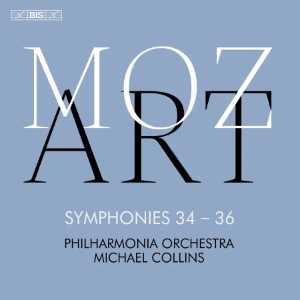
Wolfgang Amadeus Mozart (1756-1791)
Symphony No. 34 in C Major, K. 338 (1780)
Minuet in C major, K. 409 (1782)
Symphony No. 35 in D Major, ‘Haffner’, K. 385 (1782)
Symphony No. 36 in C Major, ‘Linz’, K. 425 (1783)
Philharmonia Orchestra/Michael Collins
rec. 2023, Fairfield Halls, Croydon, UK
BIS BIS2757 SACD [80]
Composed when Mozart was in his mid-twenties, these three symphonies encompass the period when he left Salzburg to seek fame in Vienna and married Constanza; as a unit they bear all the hallmarks of his musical originality and ambition, and make a full and very attractive programme, with the charming little Minuet in C major K. 409 included as a bonus. Virtuoso clarinettist Michael Collins here further solidifies his reputation as conductor directing one of London’s premier orchestras.
Probably first performed at the Archbishop’s court in Salzburg before a documented performance in Vienna in April 1781, No. 34 proclaims itself loudly with a fanfare; it is a grand, brilliant, ceremonial work designed to impress. As the notes point out, the opening gesture is reminiscent of the overtures to Così fan tutte and La clemenza di Tito; Collins accentuates that kinship. I became familiar with it via a lively recording by Sir Charles Groves with the English Sinfonia; Collins is similarly grand but even more spritely and I am slightly taken aback by his urgency, having been habituated to something a little more measured. The clarity of the SACD digital sound is almost startling; every strand of the music emerges cleanly, each perfectly balanced against the other. The Philharmonia is a big, well-oiled machine but they scale back nicely here without necessarily embracing a “period” aesthetic – apart from the evident paciness and the restrained use of vibrato. The elegant Andante is lighter on its feet than Groves, who is more wistful and inclined to apply rubato; I prefer it – but this is a case of “horses for courses”…Speaking of which, the finale gallops exuberantly and the crispness of the Philharmonia’s articulation is a joy, the timpani sharp and the woodwind biting and nasal.
The ’Haffner’ is deservedly the best known of the three symphonies here and interestingly Collins takes the Andante moderato second movement in a rather more leisurely fashion than old-timers like Beecham and Karajan. Less surprisingly, the woodwind runs in the first movement are brought out more prominently than I have heard elsewhere but the timing is conventional and Collins’ textures are so much more transparent than Karajan’s plush-velvet treatment. There is a rustic vigour to the Menuetto which is wholly appropriate and the finale bustles bumptiously – again with pleasingly audible drums, even if hard sticks aren’t being used. Karajan is considerably faster – breathlessly exciting, using the movement as a showcase for the dexterity of the BPO strings and I admit to loving that while being equally convinced that Collins is actually delivering the music rather more…well, musically.
Collins observes all the repeats in the ’Linz’ which Karajan ignores and he invests the whole symphony with considerably more vigour such that the listener is grateful for the opportunity to hear such vivacious music a second time. Collins’ opening is still grand but phrases are neatly clipped rather than etiolated and the effect is more invigorating. He also engineers more tonal and textural variation; the various colours of Mozart’s four-day-miracle of a symphony leap out: chattering bassoons, plangent oboes and trumpets are all triumphantly vivid. The Andante is courtly, graceful and unhurried, the horns smooth and sonorous; the Menuetto is likewise stately but underpinned by a certain martial spring in the step and the Presto finale scurries along, winding its way through a succession of keys in a constantly diverting manner.
The little five-minute minuet slipped between Nos. 34 and 35 makes a charming divertissement.
Neatly presented in a slim cardboard case and available at mid-price, this makes as fine a sequence of these three consecutive symphonies as one could wish for.
Ralph Moore
If you purchase this recording using a link below, it generates revenue for MWI and helps us maintain free access to the site




















